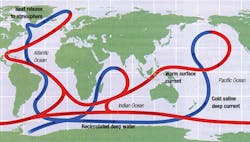Be sure to read Controlling the future, part 1
We in the automation and control profession have controlled processes with a couple of feedback subprocesses for a long time. The main difference with the global warming (GW) heat-balance process is that it has many more subprocesses with more feedback loops—some positive, others negative, some linear, others self-accelerating, some high-capacity, others low-capacity and so on. Each impacts the overall heat balance of the planet. GW models often disregard some of these feedback sub-loops, so I'll emphasize them below.
Let's first look at some of the feedback processes, which reduce GW by increasing the heat loss of the planet by reflecting more heat back into outer space. The total yearly reflection of the Earth's surface is about 250,000 Q (Q = 1,015 BTU). This amount of cooling is occurring today, when the average reflectivity of the Earth's surface is about 30%. (Reflectivity of a white surface is 100% and of black is 0%).
Therefore, one way to cool the planet is to increase its reflectivity by making the human "footprint" lighter. This can be done by converting to use lighter colored agricultural surfaces or lightly colored roofs over asphalt shingles. Increasing the total reflectivity of the Earth's surface from the present 30% to 30.1% represents an increased cooling of 850 Q—more than the total energy consumption of mankind today (about 600 Q). This negative feedback subprocess is linear, because its cooling effect is linear with the increase in reflectivity. As of today, this method of GW reduction is not yet used.
Positive feedback does the opposite, it increases GW. Some of these positive feedback processes are also self-accelerating. As we've seen, increasing reflectivity cools the planet, while decreasing it increases GW. For example, when ice melts, the reflection of solar radiation drops, because, while ice reflects 80% of the radiation received, water or land reflects less than 20%. This reduction in reflection increases heat absorption that, in the Arctic Ocean or on Greenland, for example, results in a rate of warming four times the global average. The impact of this positive feedback is self-accelerating because as heat absorption rises, more ice melts, which further reduces reflectivity and causes even more melting. At present, this positive feedback process is so fast that the Arctic Ocean may be ice-free by the summer by 2040. While melting the ice floating on the ocean’s surface has little effect on sea level, the melting of ice on Greenland does. And, while it might take centuries for all that ice to melt, when it does, the global sea level will rise by some 7 meters (23 feet).
Another example of a self-accelerating, positive-feedback process is a forest fire. These increase GW by releasing heat and carbon dioxide, which further increase the size and intensity of the next wildfire.
Two-directional feedbacks
Several of the feedback effects on GW are two directional. I'll mention only two. One is the increase of ocean temperature, which causes a drop in the solubility of carbon dioxide and consequently causes its release into the atmosphere (degassing). On the other hand, the increase in the carbon dioxide concentration in the air also causes negative feedback because it also increases the amount dissolved in the water. Evaluating which of these feedback effects is larger and by how much becomes very complex, since more carbon dioxide dissolved in the oceans also causes acidification and the killing of coral reefs.
Another example of two-directional feedback has to do with the increase in the global water cycle. As GW increases the temperature of ocean surfaces, the rate of evaporation (particularly in the Equatorial Zone) also rises. Water vapor has a powerful greenhouse effect, so increasing its concentration in the air increases GW. On the other hand, increased cloud formation triggers a negative feedback effect because, as solar radiation reaches the upper surface of the clouds, more of it is reflected back into outer space and therefore less reaches the Earth.
Inertias, capacities, time constants and dead times
High-capacity processes have high inertia, long time constants (low gains), and usually also have long dead times. This is the case with the heat content of the oceans. The mass of the oceans is 250 times that of the atmosphere, and to increase its temperature by one degree takes a million times what's required to change the temperature of the atmosphere by the same amount. This is the reason why we're already seeing changes in the atmospheric processes, while oceanic subprocesses are responding much more slowly.
The oceans contain 97% of the water on Earth, and in the short term their heat capacity plays an important role in stabilizing the climate. Another important role of the oceans is played by the ocean currents that transport heat from the warmer to the cooler regions of the planet. Currents on the surface of the oceans are mostly moved by the wind and many other effects (La Niña and El Niño) that are beyond the scope of this column.
The heat transportation process occurs because, as warm salt waters travel towards the poles, they bring heat to the east coast of the U.S. and Europe. When reaching the poles, some of it eventually freezes and leaves behind its salt content, which further increases the density of the remaining cold water. Because of its density, this heavy water sinks to the bottom of the ocean and travels back toward the tropics. So surface water is moved by the wind towards the poles and water at the bottom is moved back towards the Equator by gravity. These heat conveying currents are gigantic. For example, the size of the Gulf Current (Figure 1) is 100 times the size of all the rivers on the planet combined. Many scientists believe the Gulf Current is slowing because the melting ice in Greenland mixes with the sinking salt water and lowers its density.
The GW process is, on the one hand, like any other heat-balance processes. On the other hand, its dynamics (gains, dead times, inertias, interactions, feedback effects, etc) are the sum of the dynamics of a large number of subprocesses. In my next column, I'll try to show how this huge heat-balance process will behave if left uncontrolled, what variables we can manipulate to slow its rate of increase, and what it would take to stop it from rising and reestablish its stable, preindustrial balance.
[sidebar id=2]
This analysis in the next column will be valuable in predicting the gains, accelerations and tipping points of this process, but it will be of little value for determining how high GW will rise before stability is reached. This is because the manipulated variable (the size of the control valve in this "control loop") is unknown. This variable is a function of future human behavior, which is unpredictable. One extreme case is that mankind will leave the GW process uncontrolled; we keep burning fossil fuels until they run out. In other words, we have no control valve at all. Intermediate cases include goals that correspond to different sizes of “valves" that will slow our emissions until the carbon content of the air no longer rises, and do that in one, two or more decades. Right now, this option is the one that's being debated by our leaders. The trouble with this option is that stopping the rise in atmospheric carbon concentration does not stop GW because immense amounts of greenhouse gases are already up there.
In other words, the only full solution is to shut the “fossil valve." This will slowly eliminate that accumulated extra carbon and bring us back close to preindustrial stability. This will be achieved if we stop burning fossil fuels completely and convert to using inexhaustible and free solar energy, which can be stored and transported in hydrogen. This transformation and its control challenges will be the topic of my next column in June.
About the Author
Béla Lipták
Columnist and Control Consultant
Béla Lipták is an automation and safety consultant and editor of the Instrument and Automation Engineers’ Handbook (IAEH).

Leaders relevant to this article:


